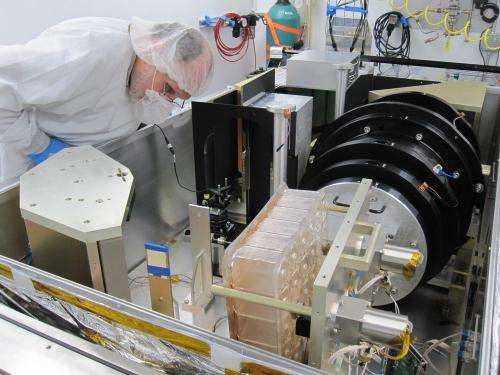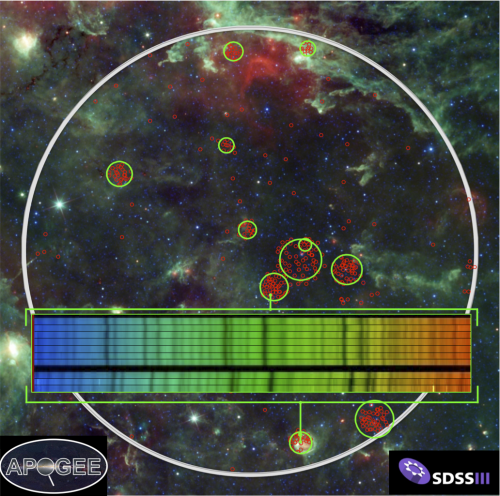New instrument peers through the heart of the Milky Way

(PhysOrg.com) -- Astronomy has a powerful new tool to probe the structure of our galaxy. The Apache Point Observatory Galactic Evolution Experiment (APOGEE) spectrograph is the newest instrument deployed by the Sloan Digital Sky Survey III (SDSS-III). The revolutionary capabilities of this high-resolution infrared spectrograph were presented today by Steven Majewski and John Wilson of the University of Virginia at the 219th meeting of the American Astronomical Society in Austin, TX.
Over the next three years APOGEE's initial census of the chemical constitution and motions of more than 100,000 stars spread all over the Milky Way will bring together data on stars with ages spanning nearly the full age of the universe, including some of the earliest ever created. These fossils of earlier times will help astronomers piece together how the Milky Way grew by devouring smaller galaxies, whose stellar entrails may still be identified through their particular chemical compositions and motions within the Galaxy.
In just the first half year of operation, the APOGEE project has observed with exquisite spectral resolution 32,000 stars throughout the Milky Way — more than four times as many stars as have ever previously been observed in such detail at near-infrared wavelengths by all of the world's telescopes combined. Observations in the near infrared are especially critical for penetrating the veil of dust that obscures most of the stars in our galaxy from view, while high spectral resolution allows for precise measurements of the chemical composition and motions of different types of stars throughout our galaxy.
"APOGEE is enabled by several novel technologies, including a sophisticated fiber optic system capable of simultaneously channeling the light of hundreds of individual stars from the telescope, one of the largest-ever deployed holographic dispersing elements to spread the light from each star into an infrared rainbow, and a 250-pound (110 kg), six-element camera with pure silicon lenses 16 inches (400 mm) in diameter used to record the vast number of stellar rainbows being created at once," said Wilson, who led the hardware team in the development of the state-of-the-art instrument.
By the end of its first three-year general survey of the Milky Way in mid-2014, SDSS-III scientists will have used the APOGEE spectrograph to derive precise Doppler motions for stars distributed throughout the Milky Way, and will, for each of these stars, measure the abundances of fifteen chemical elements, including carbon, nitrogen and oxygen — key building-blocks for life. One of the biggest advances of APOGEE over previous infrared spectrographs is its ability to gather these precise data on as many as 300 stars at once.

"The combination of infrared sensitivity and a 300-target multiplexing capability will make it possible for APOGEE to create the first-ever systematic and comprehensive probe of stars in every part of our galaxy. From this census of our Milky Way we expect many new findings about its structure, dynamics and constituent stellar populations ... and to do it hundreds of times faster than would be possible with conventional, one-star-at-a-time instruments," said Majewski, the principal investigator for the APOGEE project.
Our galaxy has three major components: the disk, where our Sun lies, a much larger but more diffusely populated spherical "halo" surrounding the disk, and a central bulge, densely populated with stars and elongated into a bar-like shape. Observing the bulge and much of our Milky Way's disk beyond the Sun's local neighborhood is challenging because huge swathes of intervening dust block much of the light at the traditional, visual wavelengths used for this type of work. Previous Milky Way surveys (like SEGUE, APOGEE's sister survey in SDSS-III, which operates at optical wavelengths) have typically avoided these dustier regions of the Galaxy.
But APOGEE's near-infrared view already is punching through the dust to reveal previously unseen phenomena in the heart of the Milky Way and beyond — to the normally hidden, far-side of the disk.
"This capability has already enabled us to discover a previously unseen pattern of stellar motions likely influenced by the Milky Way's central bar," said David Nidever, who will present some of the first scientific results from the APOGEE survey at the meeting. "I can't wait to dig into the full set of APOGEE data, which will allow us to determine the properties of the bar and the far side of the Galaxy in significantly more detail than has been possible before."
By spreading the infrared light from stars into infrared rainbows, APOGEE's spectroscopic observations allow SDSS-III astronomers to sense stellar motions through the Doppler effect, which shifts a star's spectral features by an amount corresponding to how quickly the star is moving toward or away from us. Because of the high degree with which APOGEE can spread starlight, the instrument can detect relatively small differences in motion. With such sensitivity APOGEE astronomers can identify groups of stars having highly correlated motions, a phenomenon that is often an indication of a common origin. Such data make it possible to discriminate stars born and traveling together in clusters, or that were pulled out of the same star system cannibalized by the Milky Way.

The APOGEE instrument was assembled at the University of Virginia and delivered to the Sloan Telescope in New Mexico last April. Within weeks it had recorded its "first-light" observations of a field of star clusters in the direction of the constellation Cygnus (the Swan, or Northern Cross). Star clusters are particularly valuable targets for Galactic astronomers because the distances and ages of these star systems can be estimated with much greater reliability than those of individual stars. Unfortunately, the vast majority of star clusters are commingled with the dust and myriad other, loosely distributed stars in our galaxy's disk. This mingling makes the clusters not just difficult to study but also a challenge to identify reliably. With its first observations, APOGEE proved that it could not only efficiently identify those stars that are members of clusters but in addition provide rich amounts of other information about the motions, chemical compositions, and ages of these star systems.
"These first dozen or so clusters in the 'first-light' field are just the tip of the iceberg for APOGEE. The full APOGEE survey will contain data on many hundreds of clusters, vital tools for exploring the chemical and dynamical history of our Galaxy," remarked Peter Frinchaboy (Texas Christian University), who is demonstrating findings from the APOGEE "first-light" spectra at the meeting.
Because each chemical element or molecule absorbs a characteristic set of wavelengths of light, the lines observed in a stellar spectrum reveal the chemical composition of a star. Some of the most anticipated results from APOGEE will come from exploring how the chemical compositions of stars change with their ages and locations in the Galaxy. These variations in composition come about because stars use nuclear fusion in their cores to join lighter atoms into heavier atoms. In the process of living and dying, some stars deposit those heavier atoms back into the interstellar gas clouds used to create subsequent generations of stars in the Galaxy. APOGEE's huge chemical database on so many stars will yield vital clues to how our galaxy formed in an early universe of primarily hydrogen and helium and subsequently evolved through many generations of stars to its present level of heavy element enrichment — a level sufficient to allow solar systems like our own to form with all of the necessary ingredients to produce Earth-like planets and, ultimately, life.
Provided by Sloan Digital Sky Survey


















